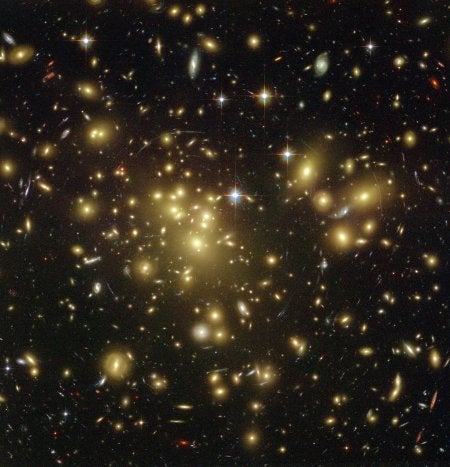A new analysis of deep-space images lends the strongest support yet to the idea of “cosmic magnification,” a phenomenon predicted by Einstein’s general theory of relativity 90 years ago, but testable only with 21st-century imaging tools and computerized data-processing techniques.
“It’s a very small effect, so you have to do this for many, many galaxies and quasars — but it’s real,” says University of Pittsburgh astrophysicist Ryan Scranton, one of the co-authors of the paper that will describe the finding in an upcoming issue of The Astrophysical Journal.
The study used thousands of deep-space images obtained by the Sloan Digital Sky Survey, which has been using a telescope at the Apache Point Observatory in New Mexico to map the position and brightness of hundreds of millions of celestial objects.
The study is based on a subtle statistical correlation: According to general relativity, galaxies will warp space so that more distant quasars – those that happen to lie on nearly the same line-of-sight, as seen from Earth – will appear brighter. Therefore, there should be a correlation between the angular separation of quasars and galaxies and the apparent brightness of the quasars. That is exactly what Scranton and his colleagues found: Quasars that appeared closest to foreground galaxies were measured to be just slightly brighter than average.
The result “appears to be another example of high-precision cosmology at its best,” said Stuart Shapiro of the University of Illinois in Urbana-Champaign. Cosmic magnification “holds great promise as a probe of structure formation, of the large-scale distribution of galaxies and dark matter, and of the overall expansion of the universe.” Clifford Will of Washington University in St. Louis described the finding as “another example of the unpredictable benefits of fundamental science research,” adding that gravitational lensing and now cosmic magnficiation are “Einstein’s gift to astronomers.”
Cosmic magnification had been detected before, but scientists were never very confident of their results because the differences in recorded brightness were barely larger than the margin of error of the observations. But with the enormous volume of data generated by the Sloan survey, Scranton says, the errors were minimized and the results are more robust.
“You need a big data set to measure this, because it’s a very small effect,” Scranton says, adding that the differences in brightness are just a few percent. “The gravitational effect on the quasars is very small, so you need a lot of quasars, which are very hard to find.”
Sloan provided data on some 200,000 quasars – a ten-fold increase over any previous survey. The survey has also cataloged 13 million galaxies.
The phenomenon of matter warping space was new when the idea emerged from Einstein’s equations for general relativity (GR) in 1915. “We’re measuring a signal that, if it wasn’t for GR, wouldn’t exist,” says Scranton.
The study may help scientists corroborate what they’ve learned about the universe using other methods during the last decade or so. The picture that has emerged is one in which most of the energy in the universe is invisible: Mysterious “dark matter” makes up some 25 percent of the cosmos, and an even-more-mysterious “dark energy” accounts for even more, perhaps around 70 percent; this dark energy may be responsible for a current acceleration of the universe first detected in the 1990s. Using techniques such as cosmic magnification to study the distribution of matter in the universe may help support or refute current theories of cosmic evolution.
“It’s a test of our picture of cosmology,” said Gordon Richards of Princeton University, one of the study’s authors.










